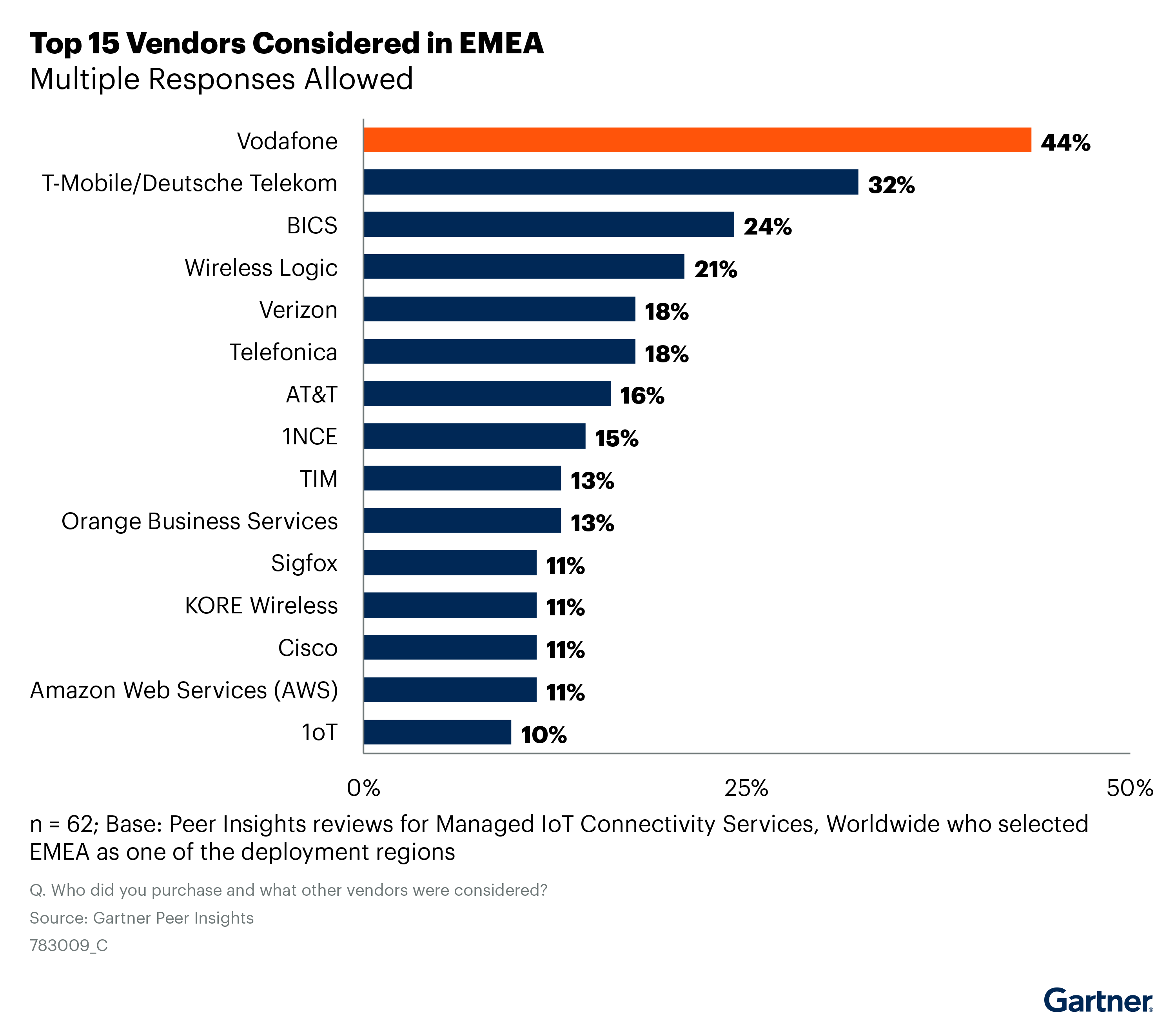The IoT market’s growth in 2023, and beyond
The IoT market is expected to grow 18% this year, reaching more than 14.4 billion active connections. Predictions even estimate that there will be more than 27 billion connected devices by 2025.
These numbers are impressive, but what insights can we extract from them? In a recent article by McKinsey, Growing opportunities in the Internet of Things, there are 3 key takeaways highlighted about the IoT market:
- Consistent growth
- Wide applications
- Significant market opportunities
Enterprises need to therefore make significant changes to their operations and business models in order to embrace these opportunities. Ultimately, all businesses seek to enhance customer experience, unlock cost savings, and improve their ROI. In fact, for more than 50% of enterprise IoT projects, cost reduction is the primary motivation.
With technology constantly evolving, keeping pace with the market (which is predicted to grow by 2% each year), and adapting to meet the changing needs and goals, can be challenging. To tackle this problem, you need intelligent managed IoT connectivity services that are flexible, scalable, and align with your specific organizational goals.
In the latest Magic Quadrant™ for Managed IoT Connectivity Services, Worldwide by Gartner®, the following findings are made about the state of the market today. We believe you can use this information to help inform your digital transformation decisions, define business goals, and know what to look for in managed IoT connectivity service providers:
- “Price Pressures Continue Impacting IoT Connectivity and Vendors Are Improving Financial Management Through ML”*
- “Effective IoT Implementation and Management Requires Strong Security”
- “3GPP LPWA Networks (NB-IoT, LTE-M) Continue Growing”
- “eSIM and Composable IoT Connectivity Is critical for Better Bring-Your-Own Connectivity Experience”
- “Managed IoT Connectivity Is a Bridge to 5G, Private Mobile Networks and Edge Computing”
- “Enterprises Seek Managed IoT Connectivity Providers With Higher Integration With Hyperscalers for Connected Products” 2023 Gartner® Magic Quadrant for Managed IoT Connectivity Services, Worldwide
Finally, to reap the benefits of a managed IoT connectivity service that works towards your business objectives and actually saves you costs, you need to effectively interpret device data. As the number of connected devices and systems grows, the volume of data generated can become overwhelming, making it difficult to process and extract valuable insights.
What do enterprises need from managed IoT connectivity services?
Companies with operations in multiple countries or regions face a number of challenges, particularly when it comes to unifying their IoT network into one intelligent entity. This unification is essential to actually drive value. Having inventory data from a factory, for example, is only useful if it can be used to save workers’ time in their daily operations. This means enterprises like yours need to process the data obtained from the devices, as well as ensure that the devices themselves are seamlessly exchanging data directly between them.
Moreover, the complex nature of multinational organizations, the need for flexible pricing and services, as well as the growing demands of the market (for eSIMs, hyperscaler integration, 5G…) create further challenges for enterprises. In order to tackle them, you need:
- Seamless connectivity, and consistent Quality of Service (QoS) across boarders: So that the customer experience and satisfaction remains consistent regardless of where the end-customer or the IoT device is.
- Self management models: To overcome the challenge of experts being needed to deploy and manage connected devices, which decreases business agility. You need autonomy and flexibility to self manage your API integrations, connectivity, devices, and applications.
- eSIMs at scale: eSIMs for IoT are both a need and a challenge, because they are extremely complicated. The eSIM requires mobile operators to integrate their respective eSIM provisioning systems (SM DR and SM DP). The GSMA eSIM Work Group 7 is currently focused on adapting eSIM technology for IoT, reusing the principles of the eSIM for the consumer devices framework and ultimately avoiding the need for back-end integration.
“MNOs are still reluctant to adopt bring-your-own-connectivity scenarios at scale or enable eSIM at scale beyond giving it to enterprises as an insurance policy in the automotive vertical. However, Gartner has observed an increasing trend among MNOs to start partnering with IoT MVNOs or even working in launching their own MVNOs to overcome this challenge and improve the response to multinational enterprises. Some Tier 1 MNOs participating in this iteration of the Magic Quadrant have shown progress in starting to adapt their systems to add third-party managed IoT connectivity platforms, but they are still in a very early phase” – 2023 Gartner® Magic Quadrant for Managed IoT Connectivity Services, Worldwide
- Business intelligence and analytics: The data obtained from IoT devices can be really valuable for your business, but for this value to be extracted, it needs to be interpreted correctly. Unfortunately, 97% of organizations feel there are challenges to interpreting IoT data in an effective and valuable way. Integration with business processes isn’t always easy, which means analytics are often not being used to optimize operations. You therefore need a business intelligence solution that is fully integrated, and interprets data to provide actionable insights.
- Security and IoT SaFe solutions: Global organizations need managed IoT connectivity services that guarantee the safe and secure transport of data across the world, whether or not they are aware of the full extent of their security needs.
“Enterprises struggle to understand the security risks that IoT devices bring to their network and technology ecosystems. Enterprise investment in IoT security is generally insufficient and reliant on provider security.” Gartner® 2023 Magic Quadrant for Managed IoT Connectivity Services, Worldwide
BICS Global IoT Connectivity Platform – everything you need to connect, optimize, and scale your business
Whatever industry you are in, your managed IoT connectivity services provider must not only help you meet your customers’ demands today, but also equip you to continue meeting them in the future. BICS’ solution provides Global IoT connectivity through tailored business models, self management tools, advanced data analytics, and value-added services such as IoT security, Digital Twin, eSim, and more.
It’s fully designed to help you easily scale your business, guaranteeing:
- Global reach: BICS’ fully-owned infrastructure provides worldwide connectivity, optimized through regional platforms with more than 140 points of presence. We’ve also been market leaders for over 20 years, and hold direct commercial agreements with the majority of mobile operators worldwide, which is a huge advantage for simplifying global deployments.
- Self-management capabilities: Our IoT connectivity platform provides everything you need to control of your global IoT deployments in real time. You can manage, monetize, and understand your customer’s business through a user-friendly, comprehensive self-service platform – as well as our whitelabel solutions for OEMs and resellers.
- Full API enablement: Integrate all the functionalities that you need via APIs, with the continued support of integration experts and our customer success team. Establish direct and secure connections to AWS, Azure, and Google Cloud through BICS’ Cloud Connect, with end-to-end security and strong SLA.
- Advanced analytics: Understand and troubleshoot problems instantly. See roaming traffic and spot trends as they appear, and detect M2M and IoT devices on your network with BICS’ business intelligence and analytics.
- Digital Twin capabilities: A connectivity twin allows the monitoring of IoT SIMs in real time, enabling accurate predictions of downtime and maintenance, and improving the overall QoS. By virtually cloning the SIM or eSIM, and obtaining a 360° digital twin of the device, enterprises can directly access connectivity information and insights. The end-to-end security view and reporting allow for faster troubleshooting and overall service improvement.
- IoT security: BICS’ IoT SaFe, Private IPX, and Cloud Connect solutions guarantee end-to-end security at each stage of the connectivity. We’ve also partnered with AWS IoT to make IoT even more secure for our customers, including the ability to: Encrypt communications between devices and the cloud with TLS 1.2; define the expected behavior of a device thanks to AWS IoT Defender; and enable network-based authentication to automate provisioning.
- Seamless connectivity for mobile private networks: BICS SIM for Things for MPN uses LTE/ 5G to keep devices securely connected both inside and outside of private networks, switching seamlessly between them, and therefore removing complexity.
To find out more about how BICS’ managed IoT connectivity services could help your business’ digital transformation and increase profit margins, please get in touch.
BICS placed third in the “Top 15 managed IoT connectivity vendors considered in EMEA” region, in the Gartner® Peer Insights™ report, download the report.

BICS is recognized as a Niche Player in the 2023 Gartner® Magic Quadrant for Managed IoT Connectivity Services, Worldwide.
*Machine Learning
Gartner® Magic Quadrant for Managed IoT Connectivity Services, Worldwide, By Pablo Arriandiaga, Eric Goodness, Kameron Chao, Jon Dressel, 30 January 2023
This graphic was published by Gartner, Inc. as part of a larger research document and should be evaluated in the context of the entire document. The Gartner document is available upon request from BICS.
GARTNER is a registered trademark and service mark of Gartner, Magic Quadrant and Peer Insights are registered trademarks of Gartner, Inc. and/or its affiliates in the U.S. and internationally and are used herein with permission. All rights reserved.
Gartner Peer Insights content consists of the opinions of individual end users based on their own experiences with the vendors listed on the platform, should not be construed as statements of fact, nor do they represent the views of Gartner or its affiliates. Gartner does not endorse any vendor, product or service depicted in this content nor makes any warranties, expressed or implied, with respect to this content, about its accuracy or completeness, including any warranties of merchantability or fitness for a particular purpose.
Gartner® does not endorse any vendor, product or service depicted in its research publications and does not advise technology users to select only those vendors with the highest ratings or other designation. Gartner® research publications consist of the opinions of Gartner’s ® Research & Advisory organization and should not be construed as statements of fact. Gartner® disclaims all warranties, expressed or implied, with respect to this research, including any warranties of merchantability or fitness for a particular purpose.
Editor’s note: This blog was first published on 22 February 2023 and updated on 30 October 2023.
